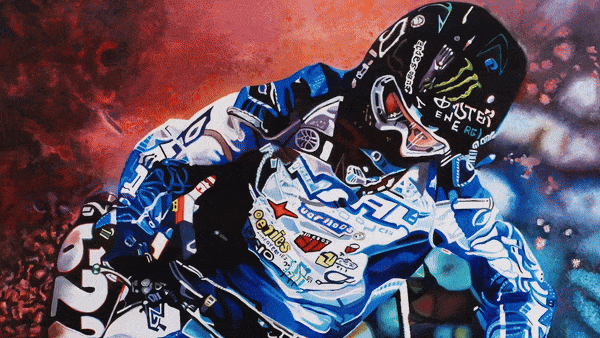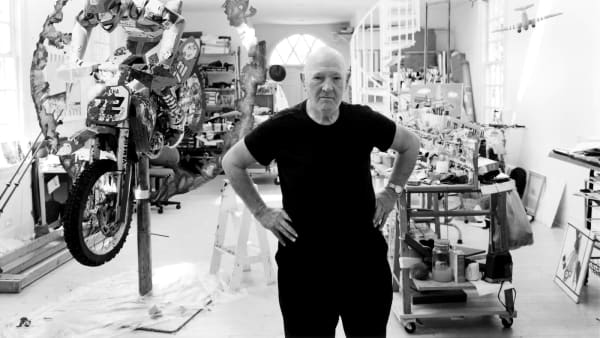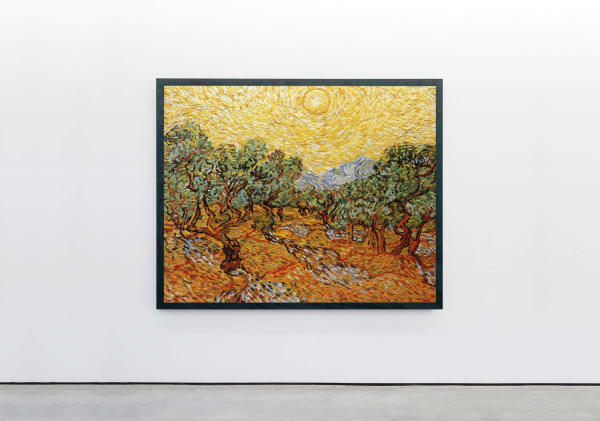-

-
"While waiting for a train in Pennsylvania Station, I came across a motocross magazine with a cover featuring a young motocross rider and a colorful bike in midair doing an impossible maneuver in a sky. For me that is the modern myth. A myth has to have a hero. A hero has to face danger and death, have flaws and an Achilles' heel."
– Malcolm Morley
Malcolm Morley's renowned motocross paintings find their roots in photojournalism, seamlessly blending his realistic style honed in the 1960s with a masterful transition towards artist's abstract vision. In his constant exploration of imagery, Morley skillfully juxtaposed lifelike depictions of riders with abstract renditions, symbolizing the challenge of tracking objects at high speeds.
-
 Malcolm Morley. Thor, 2008 (detail) © Gary Tatintsian Gallery and the artist
Malcolm Morley. Thor, 2008 (detail) © Gary Tatintsian Gallery and the artist -
'Thor,' 2008, emerges as a unique blend of Morley's Super-realism and Neo-expressionist styles—a testament to artist's continually evolving painting format. Morley portrayed the motocross rider as a mythic hero, depicting a contemporary mythology in paint. The penciled grid at the edges and scattered bits of paper beneath the racer subvert Morley's photorealistic approach. An authentic racing glove (crafted by the famous moto gear manufacturer 'Thor Motocross') pinned to the painting's lower right corner further emphasizes the racer's ethereal nature.
-
Morley's dedication to photorealism not only showcased his technical skill but also reflected his broader artistic philosophy. Drawing inspiration from photographs and postcards, the artist often incorporated a gridded structure —a technique employed by many artists, such as Chuck Close, Richard Estes, and Audrey Flack, to achieve precision and accuracy in their compositions. Expanding on his pictorial innovations, Morley began integrating new elements of imagery and abstraction into his paintings, transforming realistic images into his unique interpretation of Surrealism.
"It's much more difficult to make an abstract painting that is real than an abstract painting that is abstract."
– Malcolm Morley -
'Thor' exemplifies Morley's later work, characterized by unexpected juxtapositions of objects and scenes that imbue his paintings with a dreamlike quality. Vibrant images on his canvas seem to explode, evolving into mosaics of miniature abstract artworks, blurring the distinction between background and foreground as they seamlessly merge into one another.
-
Throughout his illustrious career, Malcolm Morley (1931–2018) defied easy stylistic categorization while remaining deeply influenced by his own life experiences. His works are prominently featured in major museums and private collections worldwide. Morley received the inaugural Turner Prize in 1984, the Painting Award from the Skowhegan School of Painting and Sculpture in 1992, and the Francis J. Greenburger Award in 2015. In recognition of his contributions to the arts, he was elected to the American Academy of Arts and Sciences in 2009 and the American Academy of Arts and Letters in 2011.
-
"I don't think of the photographic source of a painting as second-hand information. For me it is first-hand. The greatest difference between the Pop artists and me is that they wanted to get rid of touch and a sense of the hand-made. I make a hand-made painting from a ready-made."
– Malcolm Morley
-
-
-
Find out more
-
-
ONLINE EXHIBITIONS
Viewing Room | Malcolm Morley. Thor, 2008
Past viewing_room















